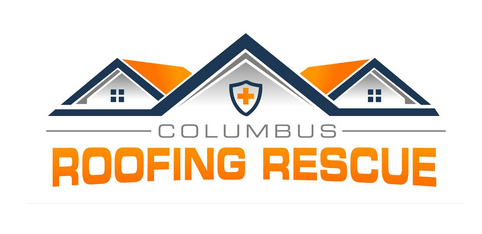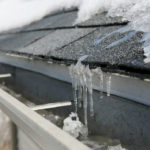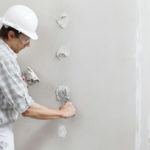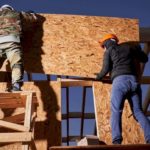
How to Spot Hail Damage On Your Roof
Hail damage on roofs is a more common occurrence in areas that experience heavy storms. Hailstones might crack shingles, potentially causing water damage to your home. While some roofing materials like metal resist hail better than others, giant hailstones can cause untold damage to your roof.
In addition to staying updated on daily hail reports, you can mitigate the impact of hail damage by inspecting your roof regularly and fixing any signs of hail damage as soon as possible. Here’s how to identify hail damage on the most common types of roofs.
Signs of Hail Damage on Asphalt Shingle Roofs
In most cases, signs of hail damage on shingles include bruising, round black areas, small divots, and maybe even several missing shingles. You may also notice a heap of granules in the downspouts and gutters. Granules protect the shingles from damage, so once they’re knocked off, it exposes your shingles to further hail damage.
Today’s asphalt shingles are durable and withstand considerable hail attacks, extreme temperature changes, rain, snow, and ice. But as they wear out, they shed their protective layer and ultimately become unable to withstand storms that were previously not much of a threat.

Remember that not all hail damage on asphalt shingles can be seen from the ground. You won’t notice shingles that are cracked on the backside without the help of a roofing contractor.
Moreover, the roofer will inspect other areas of your roof that protect your house, including flashing, gutter, skylights, chimney covers/caps, and roof vents.
Signs of hail damage on asphalt shingles include:
Missing or Cracked Shingles
A missing shingle is the most obvious sign of hail damage, and it’s a surefire sign that other parts of your roof are at stake. On the other hand, cracked shingles mean moisture will get into your home’s interior. Both scenarios require immediate intervention by a qualified and experienced roofing contractor.
Dented Penetrations
This is the next worst hail damage after missing or cracked shingles. When large hailstones hit your roof at great velocity, the denting can cause penetrations on the shingle’s surface. After that, any moisture that lands on your roof will likely result in interior water damage.

The most popular roofing material out there is asphalt shingles. While asphalt shingle manufacturers are making more durable products today, they’re still susceptible to failure during heavy storms with hail. Even if you can’t see these signs of hail damage, inspecting your roof regularly is best, particularly if it’s aging.
Missing or Damaged Flashing
Flashing is vital to your roof because it helps guide rainwater away from the roof and into your gutters, where the downspouts take it away. If the flashing is missing or damaged, water won’t be moved away from your home, and it’s likely to get under the shingles and leak into your home.
Granule Accumulation
Protective granules are found on the outermost part of the shingle. They’re your roof’s first line of defense when it’s attacked by inclement weather. Hailstones will knock granules off and typically collect in downspouts and gutters. When your shingles are missing a fair amount of granules, hail damage can happen more frequently and easily.
Dark Spots
If your shingles are pockmarked with dark spots, that’s the black asphalt layer below the outermost layer. Older roofs typically develop dark spots more frequently than newer ones because older roofs will have lost their granules and are susceptible to the devastating effect of hailstones and other windstorm debris.
Signs of Hail Damage on Slate Tile Roof
Thanks to its beauty, sturdiness, and durability, slate is another roofing material. But slate roofs are also susceptible to hail storm damage like other roofs.
Signs to keep an eye on include:
Broken Slate Tiles
A severe hail storm can break slate tiles down to the point they require immediate replacement. Also, large hailstones and slate tiles already structurally weak can contribute to damage.
Punctures or Fractures within Slate Tiles
If your slate tile roof shows signs of fractures or punctures, it could be a sign of hail damage. The impact of hail won’t completely break the slate tiles but will cause a series of holes or fractures.
Holes
A hail storm creates holes that are, by and large, clean, crisp, and with sharp edges. Another sign of hail damage on slate tiles is broken edges or corners.
It’s easy to identify hail damage on a slate roof, especially if the hailstones are large since they create holes, pits, cracks, breaks, and pockmarks. If your roof is made of soft slate or worn out, hail damage will likely occur more often because the tiles are brittle.
If your roof has just one layer of material and is damaged to the extent that water can penetrate the slate, you’ll experience leakage problems inside your home.
Signs of Hail Damage on Metal Roofs
Metal shingles are available in several options, including steel, aluminum, and copper. While metal roofs are durable and last decades, large hailstones can damage them.
Signs to check for include:
Scouring
After a heavy stone, signs of damage can appear on the metal coating. Also known as scouring, scratch marks appear along the panels, causing the coating material to come off.
Dents

Depending on the hail’s size and the speed at which it travels, hail can cause small, medium, or massive dents on metal roofs. When the metal roof is hit with hail stones, the panel is dented or pocked with multiple indentations.
Rust
While hail sometimes causes nothing more than cosmetic damage, fractures and dents can easily cause rust, leading to the deterioration of affected metal panels. The damage’s extent depends on the storm’s severity and the type of metal roof installed.
The Takeaway
Hail damage on your roof can be minor, mild, or severe. If you’ve had your roof professionally inspected and there are signs of hair damage, make sure it’s fixed right away by hiring an experienced roofer.
Now that you’re pretty clued up on common signs of hail damage on roofs, you can minimize the impact and keep your roof strong and healthy for decades.



